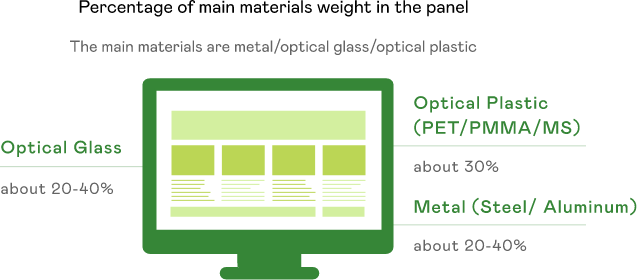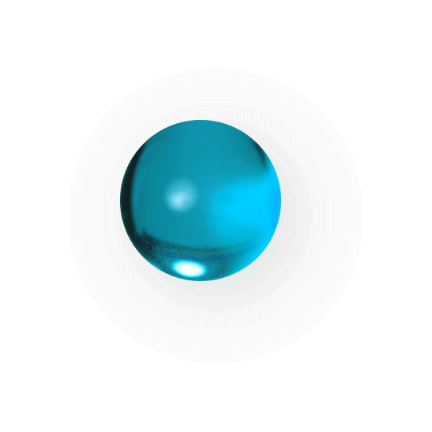Raw materials with low environmental impact and risk.
AUO is committed to advancing sustainable products, promoting product innovation and upgrades through outstanding technology, and assuming extended producer responsibility. We actively respond to stakeholders' expectations for sustainable products. We evaluate the environmental and human impacts of each stage of the product life cycle, giving top priority to selecting raw materials with low environmental impact and risk from the raw material stage. We collaborate with value chain partners to develop sustainable materials, ensuring that AUO's products and services are safe for human health and the environment.

Traceability and source management of raw materials
AUO has established a supplier management standard for raw materials, requiring suppliers to comply with AUO's sustainable material GPARS standard based on international regulations such as REACH, GADSL, and IEC 62474. AUO incorporates this standard into its procurement process, and all material suppliers must fill in relevant necessary information in theGPARS (Green Parts Aggregation and Reporting System)including information about the raw material manufacturers.

In addition, we also require suppliers to continuously reduce their organizational carbon emissions and expand the use of recycled materials to further reduce the energy consumption impact of raw material production.
Critical raw material assessment
AUO's main product is display panels, with the main raw materials used in panel manufacturing being glass substrates and LCD module displays manufactured through semiconductor processes, along with related components and material assembly. In order to select raw materials with low environmental impact and risk, we conduct a critical raw material analysis assessment on the raw materials we use during the product life cycle's raw material stage, including material composition and weight proportions. Based on the analysis results, we identify critical raw materials and prioritize the use of recycled materials.
AUO is leading the industry by using 30% post-consumer recycled plastics in plastic frames, demonstrating a commitment to the use of recycled materials. Additionally, AUO is exploring the application of high-quality optical-grade recycled plastics, such as optical films and light guides, which require advanced quality and technology. AUO continues collaborating with suppliers capable of physical and chemical recycling to develop recycled materials and validate product feasibility.
Distribution of key raw materials for


Utilization of recycled materials in products
Recycled Steel
Galvanized steel products with UL 2809 Recycled Material Content Verification for steel bezel application.
Recycled Aluminum
Reuse scrap aluminum and recycled aluminum parts for aluminum bezel application.
Metal Raw Materials and Recycled Matel Raw Materials introduce
In 2024, AUO produced have a total of 2,245 metric tons of aluminium components and use for sputtering targets in its products, with 91 metric tons consisting of recycled aluminium materials components. The recycled aluminium materials account for 4.08% of the total aluminium materials used in AUO products.
In 2024, AUO produced have a total of 655 metric tons of copper use for sputtering targets in its products. Due to the metal purity requirements in the process, no recycled materials are used.
In 2024, AUO produced have a total of 16,587 metric tons of iron/steel components in its products, with 123 metric tons consisting of recycled iron/steel materials. The recycled iron/steel materials account for 0.74% of the total iron/steel materials used in AUO products.
Cobalt, Nickel, Lithium, Titanium are not the main components of AUO products, so no relevant data are collected.
Recycled Glass
Glass substrate supplier provides approximately 20% of PIR recycled content substrate and continues to study ways to improve the recycle content further.
Optical Grade Recycled Plastic - Optical PET Film
Optical-grade recycled PET certified by the Global Recycle Standard (GRS) with optical films for diffuser and prism application
Optical Grade Recycled Plastic - Light Guide (PMMA/MS)
The PCR or PIR plastic waste is processed using thermochemical technology to regenerate MMA plastic raw materials, which are then used to produce optical- grade plastic light guide plate.
Recycled Plastic - (PC)
AUO use PCR recycle plastic Polycarbonate (PC) for the plastic frame.
Plastic Raw Materials and Recycled Plastic Raw Materials introduce
In 2024, AUO completed the development of demonstration 24-inch monitor products with a 50% recycled material content. The product materials include a plastic frame with 50% recycled material, a glass substrate with 20% recycled material, and a metal backplate with 90% recycled material.
In 2024, AUO produced a total of 28,642 metric tons of plastic components in its products, with 485 metric tons consisting of recycled plastic materials. The recycled plastic materials account for 1.69% of the total plastic materials used in AUO products.
Strategy for the introduction of sustainable recycled materials
AUO has set targets for promoting the adoption of sustainable recycled materials and has arranged for research and development teams to participate in training with a focus on sustainable materials. This effort aims to continuously improve AUO's capabilities in green research and development.
Goals for sustainable & recycled materials
| 2023 Summary | 2023 Summary | 2025 Target | 2026 Target | |
|---|---|---|---|---|
| Shipment volume of products using recycled materials | Actual:4.22 million pieces | Target:1.8 million pieces Actual:6.47 million pieces |
Target:2.4 million pieces | Target:3 million pieces |
| The weight proportion of recycled materials used in special regulation products. 2021 as the base year | Actual:20% | Target:30% Actual:50% |
Target:30% | Target:30% |
| Ratio of recycled materials certification for the circular economy supply chain | Actual:90% | Target:90% Actual:100% |
Target:90% | Target:95% |
Introduce recycled materials into product mechanical components such as plastic frames and metal back plates, and different recycle materials solutions are available for customers to choose from.
| 2023 Summary | 2024 Summary | 2025 Target | 2026 Target | |
|---|---|---|---|---|
| Hazardous substances in product meet AUO hazardous substances for green products requirement (including international hazardous substances regulations and client requirement) | Actual:100% | Target:100% Actual:100% |
Target:100% | Target:100% |
| New trading suppliers sign the compliance statement of AUO suppliers and contractor’s guideline | 100% | Target:100% Actual:100% |
Target:100% | Target:100% |
Note: The content of the guidelines is based on the Responsible Business Alliance (RBA) framework, including five major aspects: labor rights, health and safety, environmental protection, ethical standards, and management systems. In response to international trends, AUO will incorporate biodiversity, forest protection, soil protection, carbon reduction and energy saving, supplier management, and other projects into the guidelines starting from 2023 to more comprehensively assess the sustainability governance of suppliers.
Introduction process of sustainable recycled materials
Enhancing sustainability material intelligence
We hold periodic training sessions focusing on sustainable materials, with course topics including green product regulations and certifications, hazardous substance management, recycled material verification, etc., to continuously enhance AUO's capabilities in green research and development.
Courses
10
Number of trainees
25666 attendance













